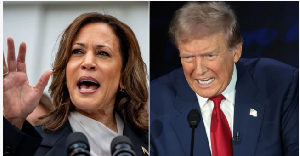 US Vice President Kamala Harris and former president Donald Trump
US Vice President Kamala Harris and former president Donald Trump
E neva really happun for recent US political history say dem go doubt di outcome of a presidential election - dis no be contest for those wey dey faint for heart.
While past elections don dey narrowly decided - George W Bush 2000 victory ova Al Gore come down to a few hundred votes for Florida.
E dey always get some sense which direction di race go go for di final fays.
Sometimes, as for 2016, di sense dey wrong. For dat year, polls overestimated Hillary Clinton strength and fail to find say late-breaking movement in favour of Donald Trump fit dey.
Dis time around, howeva, di arrows dey point different directions.
No-one fit seriously make a prediction either way.
A coin-toss
Most of di final polls dey well within di margin of error, both nationally and for di seven key battleground states wey go decide di election.
Based on statistics and sample sizes alone, e mean say either candidate fit dey ahead.
Na dis uncertainty dey vex political pundits and campaign strategists.
E get different surprises, even a recent respected survey of Republican-leaning Iowa dey give Harris a shock lead.
But di major polling averages, and di forecasting models wey interpret dem, all dey show say dis na coin-toss contest-- anybodi fit win.
A clear winner still dey possible
Just becos di outcome of dis election dey uncertain, dat no mean say di actual result no go dey decisive.
A shift of a few percentage points either way fit make a candidate sweep all of di battleground states.
If di voter turnout models dey wrong and more women head to di polls, or more rural residents, or more disaffected young voters - dat fit dramatically shift di final results.
Surprises fit also dey among key demographic groups.
One question na if Trump go really get close to young black and Latino men wey im campaign don predict?
Harris go fit win ova a larger proportion of traditional Republican suburban women, as her team dey hope?
Elderly voters wey dey vote for every election and tend to lean to di right go fit move into di Democratic column?
Once dis election dey for rear-view mirror, we fit dey able to conclusively point to a reason why di winning candidate come out on top.
By dat time, di ansa go dey obvious. But anyone wey say dem know how tins go turn out right now just dey fool you - and demsef.
Blue Walls and Red Walls
For most US states, di outcome of di presidential vote na all but certain. But e get seven key battleground states wey go decide dis election.
Not all battleground states dey created equal. Each candidate get a "wall" of three states wey offer di most direct path to di White House.
Harris so-called "blue" wall, named for di colour of di Democratic Party, stretch across Pennsylvania, Michigan and Wisconsin for di Great Lakes region.
Dis na di subject of much political conversation since 2016, wen Trump narrowly win all three traditionally Democratic states for im way to victory.
Joe Biden turn dis states back for 2020. If Harris fit hold dem, she no need any oda battleground, as long as she also win a congressional district for Nebraska (wey dey different system for how e award electoral college votes).
Dat explain why she don spend plenti of her time for dis blue wall states during di campaign final stretch, wit full days on di ground for each.
On Monday night, she hold her final rally for Philadelphia, Pennsylvania, at di top of di 72 steps leading to di city Museum of Art, wey Sylvester Stallone fictional boxer Rocky climb for di film of di same name - bifor narrowly losing to im opponent, Apollo Creed.
Trump "red wall" sit along di eastern edge of di US. Dem no dey too tok about am but e equally dey important to im electoral chances.
E start for Pennsylvania but stretch south to North Carolina and Georgia
If e carry dia states, e go win by two electoral votes, no matter how di oda battlegrounds vote.
Dat explain why e hold five events for North Carolina for di last week.
Di overlapping point on each of dis walls, of course na Pennsylvania - di biggest battleground electoral prize.
Di nickname, di Keystone state, neva dey more appropriate.
America future for di balance
Sometimes, wetin dey all dis electoral map na to strategise and play game -- and dat na di historic significance of dis presidential election
Harris and Trump represent two very different views of di US - on immigration, trade, cultural issues and foreign policy.
Di president for di next four years go dey able to shape American govment - including di federal courts - for way wey fit get impact for generations.
Di US political landscape don dey change dramatically ova di past four years wey dey reflect shifts for di demographic make-ups of both parties.
Di Republican Party of a decade ago dey look veri different to di populist one wey Trump dey lead, wey get far more appeal to blue-collar and low-income voters.
Di Democratic Party base still rest ontop young voters and pipo of colour, but e now rely more on di wealthy and college educated.
Tuesday results fit offer additional evidence of how dis shifts for American politics, dey reshape di US political map.
And those shifts fit give one side or di oda an advantage for future races.
E no dey too long ago - for di 1970s and 1980s - wey Republicans dey viewed as party wey get di presidency becos dem consistently win a majority for enough states to prevail for di electoral college.
Dis election fit be a 50-50 contest, but dat no mean say na di new normal for American presidential politics.